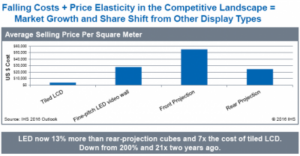Jennifer Davis is from Planar/Leyard which, of course, covers both LED and LCD technologies in its “consultative selling” business.
The choice of the right display starts, of course, with the applications and customer requirements. It’s not always a simple decision. Within the niche of high brightness, there are a number of vertical applications including aviation, retail, education, sports arenas, corporates, museums and hospitality (including QSRs).
Customers want “everything”, but the aim is to get as close to that as they can afford. They are looking for seamless images and high reliability. The displays have to be bright enough and have “wide enough” colour to have the right impact for the brand. The bar has been set high by the high quality of consumers’ mobile devices which have wide gamut and high resolution.
Davis said that fine pixel pitch (FPP) is growing fast and displays with pitch of less than 2mm grew 279% in 2015 and the segment is expected to continue to grow rapidly. Trade shows have seen many more players active and established players have been bringing products to market. Falling price has meant high change dynamics in the market.
 Planar showed this comparison of different display technology costs – it could
Planar showed this comparison of different display technology costs – it could
Tiled LCD is a low cost way to get big displays. LEDs are now only around 13% more expensive than rear projection cubes. Davis said that FPP LED is around seven times more expensive than LCD, but two years ago they were 21 times more expensive. The key point is that emissive displays just look good. Interestingly, Davis said that projection is no longer suited for digital signage.
There are ‘non-trivial’ challenges to move to smaller and smaller pitches. There’s a need for a lot of education needed for users – from “what is pixel pitch”.
When does LED go past video wall in sales? the shift is already happening in control rooms, Davis said, and is starting to change in digital signage.
Analyst Comment
I’m not convinced about the argument that front projection is out of the picture for digital signage. Where the ambient light is at all controllable, the new lampless light sources and technology such as the mirror systems that can direct the image beam are making projection a more acceptable and flexible alternative, in some cases, to flat panel displays. I also wonder about the 7X price difference claim between LED and LCD. It’s probably true if you take the same pixel pitch and resolution, but where viewers are some way back from the display, and you can move to larger pitches, the LED becomes competitive with LCD. (BR)

